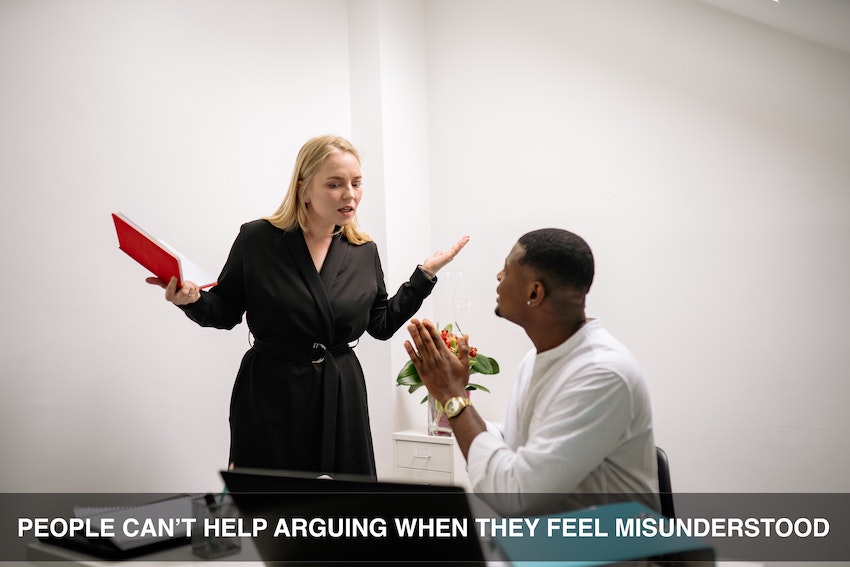How To Handle Difficult Clients
Training In How To Diffuse Tension And Maintain Positive Relationships
Refine your communication skills by learning to harness your emotional intelligence with one of the UK's most acclaimed management training courses.
Why Choose This Training?
More Than Just A Course Of Lectures
What gets in the way of developing and holding on to new communication skills are old habits of thinking and speaking. Even if the advice is very good the reason why it rarely sticks are the mental habits people inevitably revert to, especially under pressure.
Unlearning those old habits and internalising a more effective and lasting approach to communication needs more than a short course of lectures on how to do it.
What Makes This Training Stand Out?
What makes this training stand out is the exceptional support through one-to-one coaching sessions and continuous feedback. Changing behaviour is not an easy task as old habits are hard to break.
With a 40-year track record we can help you cultivate practical skills, and build your confidence to so you can successfully navigate real-world challenges, ensuring lasting behavioural improvements.
Testimonials
Join thousands of participants getting results
"What I love about this course is that I didn't just learn about the topic, this course is about ME. I'm confident I can reliably use my new skills, even when under pressure".
![]()
"A lesson for life! The power of effective communication is incredible when one masters the skills "listening with empathy" and "speaking assertively"
![]()
Clients We Have Worked With
Well-known companies who have used this course again and again, over many years
Course Summary
Training Objectives
Handling difficult clients can feel like a tightrope walk. It's common to meet such challenges, no matter your field. This training course reveals that through specific strategies, you can diffuse tension and maintain positive connections.
We'll guide you on how to turn these challenging situations into opportunities for growth... and to make peace.
- Spot signs of difficult clients early, like quick anger or hard to please, to manage situations better.
- Use emotional intelligence for effective communication. Listen well, understand their perspective, and avoid blaming language.
- Set clear boundaries and learn how to handle conflicts smartly. Work together on finding solutions that benefit both sides.
- Know when it's time to end a client relationship if it harms your well - being or trust is lost despite efforts.
- Learn from every situation with tough clients to improve future interactions. Reflect on what happened and make necessary changes.
Develop Your Emotional Intelligence
You will learn a set of powerful emotional intelligence communication techniques so that you can manage difficult conversations, handle challenging situations, build relationships and set firm boundaries.
Transferable Skills
The goal of this training is to equip you with the tools you need to build strong, lasting relationships in your professional life, although because these skills are so transferable many clients report vast improvements in their personal relationships as well.
Develop Skills
This is a skills development rather than just a theoretical programme, so the emphasis throughout will be on you taking turn after turn, practising your skills, while receiving feedback and coaching about your effect on others.
Repeated Practice and Feedback
In your coaching sessions you will be helped to practise dealing with the kinds of situation you find challenging, again and again, until you are confident you can do it successfully.
Video Analysis
We'll combine practical, hands-on experience with video replay and analysis and discussion of the principles involved to help you gain both skills and understanding. Special attention is paid to your individual training needs, so you can practise your skills in real-life situations that you have to handle at work.
Sustained Change
That's why as well as your place in a small group, this training includes a generous amount of private and confidential one-to-one coaching sessions online, spread over several months, ensuring an exceptional level of support. This will ensure the changes you make are sustained over a longer period of time and any obstacles are overcome. Choose between online training available worldwide, or in-person face-to-face courses in the UK.
Course Dates and Price
For a list of upcoming course dates (for online coaching and face-to-face training), the locations of the next 3-day public courses in the UK and pricing Click here.
Free Initial Session
This initial coaching session serves as an introduction to the "Skills with People" course, allowing you to understand the course's relevance and effectiveness for your specific needs before committing to it.
Related Articles
The Art And Science Of Great Customer Service: Focuses on improving customer service through emotional intelligence, effective communication, and ongoing support. We highlight our unique to training approaches, which includes lots and lots of personalised coaching and feedback aimed at lasting behavioural change.
Better Client Relationship Management Skills: This centres on building strong client relationships using emotional intelligence (EQ), understanding client needs, and creative problem-solving. We emphasise how personalised coaching which aims to improve communication skills can enhance client satisfaction.
Customer Service Training Course for Managers and Professionals: This is an overview page that summarises our approach to customer service training. We stress the importance of understanding customer needs, conflict resolution, and emotional intelligence. It showcases our commitment to practical skills development through repeated practice, feedback, and one-to-one coaching sessions, aimed at improving professional and personal relationships.

Understanding Difficult Clients
Getting to know difficult clients is key. It's about spotting the warning signs and figuring out why they act tough.
Identifying the signs
Spotting the signs of a difficult client early can save you lots of stress. They might show aggression or quickly get upset over small things. Their demands could be unreasonable, often changing what they want without notice.
Some clients ignore your advice, thinking they know better. A key sign is when they are not clear about what they want but still expect perfect results.
Clients who refuse to communicate effectively pose a big challenge, too. They might not answer calls or reply to emails promptly, making it hard to move forward with their projects.
Watch for those who blame you for everything that goes wrong – even when it's out of your control. These behaviours signal that resolving conflicts constructively might be tough with this person.
Reasons for difficult behaviour
Clients might act out for many reasons. They could feel stressed or under pressure, making them short-tempered. Perhaps they're not happy with the service and don't know how to express their feelings without getting upset.
It's also possible they're dealing with personal issues that have nothing to do with you, but it spills over into your interactions.
Understanding these triggers is crucial in resolving conflicts constructively. By acknowledging what’s really going on, you can address the root of the problem instead of just the symptoms.
This approach helps in maintaining a healthy relationship and finding common ground despite differences.

The Importance of Handling Difficult Clients
Handling tough clients is key. It keeps relationships good and cuts down on troubles.
Maintaining positive relationships
Keeping good relationships with clients is key. It helps in solving problems faster and makes each project smoother. We need to talk openly, listen well, and work together. This shows respect and builds trust.
Both sides feel safe and valued.
Finding common ground is also important. It helps us see the other person's point of view better. This way, we can solve conflicts in a positive way that works for everyone involved.
Mitigating potential risks
Mitigating potential risks means preventing problems before they start. By understanding the signs of aggression and setting clear boundaries early on, you can avoid tense situations in your relationships with clients.
This process involves engaging in open and effective communication, ensuring both parties find common ground.
To manage stress and emotions effectively, remain calm during interactions. Focus on finding collaborative solutions that benefit everyone involved. This keeps conversations constructive and helps maintain healthy relationships, even when facing challenges.

Identifying Difficult Clients
Spotting difficult clients early can save a lot of stress. They often show signs, like being quick to anger or hard to please, which signals it's time for careful steps.
Signs of aggression
Dealing with difficult clients involves spotting signs of aggression early on. These red flags can help you prepare and respond effectively.
- Raised voice: A client might start speaking louder than usual to dominate the conversation.
- Harsh words: Watch out for language that's mean or hurtful. This shows they're losing patience.
- Interrupting: If a client keeps cutting you off, it's a sign they're not valuing your input.
- Body language tells a lot too. Crossed arms and leaning away signal they're not open to discussion.
- Eye contact... or lack thereof. Avoiding your gaze can mean they're not engaged or are feeling hostile.
- Quick changes in mood hint at instability, which could lead to aggressive outbursts.
- Making demands: Insisting on quick, unreasonable solutions shows frustration and aggression.
- Refusing to listen to explanations signals a closed mind, often leading to conflict.
Recognising these signs gives you a chance to de-escalate the situation calmly and constructively.
Aggressive behaviour red flags
Identifying aggressive behaviour in clients early can help manage conflicts. It's vital to keep an eye out for these signs to maintain a positive relationship. Here's what to watch for:
- Raised voice: Clients might raise their voices out of frustration or anger. This is a clear sign they're feeling agitated.
- Interrupting often: If a client keeps cutting you off, it shows they're not valuing your input.
- Pointing fingers: Literally pointing fingers or blaming others without taking any responsibility is a red flag.
- Refusing to listen: When clients won't consider your perspective, it's tough to find common ground.
- Making threats: Any form of threatening language indicates things are escalating too far.
- Insults or name-calling: Resorting to personal attacks is disrespectful and unproductive.
- Body language: Clenched fists, narrowed eyes, and invading personal space are non-verbal cues of aggression.
- Unwillingness to compromise: If clients resist any form of compromise, resolving conflicts constructively becomes difficult.
- Demanding immediate answers: Expecting instant solutions without understanding the complexity shows impatience and disrespect.
- Over-generalising: Statements like "You always" or "You never" indicate black-and-white thinking which is rarely accurate or fair.
Recognising these behaviours early on can guide how you manage interactions and work towards diffusing tension.

Effective Communication with Difficult Clients using Emotional Intelligence
Talking to tough clients? Emotional intelligence is key. It lets you listen well and understand what they really feel, making conversations smoother.
Active listening with empathy
Active listening with empathy is all about giving your full attention to the client. It means really hearing what they're saying, not just waiting for your turn to talk. You listen with your ears, yes, but also with your eyes and heart.
This shows the other person you value their perspective and feelings. It's like putting yourself in their shoes to understand where they're coming from.
To do this well, nod and make eye contact. Ask questions that show you're engaged and interested in getting to the root of their concern. Empathy doesn't mean agreeing with everything they say, but it does mean respecting their right to speak, and demonstrating you’re doing your best to understand what’s important to them.
Through active listening, you build trust... And trust is gold when resolving conflicts constructively with difficult clients.
Non-verbal communication
Body language speaks volumes. With clients, your facial expressions, gestures, and posture can either ease the tension or make things worse. A calm face and open stance show you're ready to listen.
Nodding shows you understand their concerns without interrupting them.
Eye contact is key too – it builds trust. But, don't stare so much they feel uncomfortable! Small changes in how you stand or look at someone can help keep the conversation positive.
It's all about making the other person feel heard and respected without saying a word.
Acknowledging the other's perspective and feelings for conflict resolution
Seeing things from the client's point of view is key. It shows you get their feelings and worries. This step makes them feel heard and valued, which can calm tense moments. You might not agree with everything they say, but acknowledging their stance can build trust.
Talking about their feelings openly helps too for conflict resolution. Ask how they're feeling and listen closely to their reply. This caring approach often leads to better understanding on both sides. It paves the way for solutions that benefit everyone involved, keeping relationships strong even in tough times.
Avoiding accusatory language
Avoiding accusatory language keeps the conversation light and open. Use words that show you understand their feelings and perspective. This makes them feel heard, not attacked. Speak about issues without pointing fingers.
Say "I noticed..." instead of "You did...". This small change can lower tension.
Focus on shared goals, not on who's right or wrong. Talk about how to solve problems together. Keeping a calm tone helps everyone stay cool, even in tough chats. So, talk more about fixing things and less about blame.
This way, both parties work towards a solution rather than argue over the problem.

Setting Boundaries and Managing Conflict
To deal with tough clients, setting clear boundaries and handling conflicts smartly can make a big difference. Check out more for helpful tips on keeping things smooth.
Identifying the problem
Spotting the issue at hand is a crucial first step in managing conflict. You need to listen carefully and work out what's really bothering your client. This might involve peeling back layers of frustration or misunderstanding.
Once you know what the core problem is, finding solutions becomes much easier.
Working together on this helps, too. It shows that you're on their side and keen to resolve the issue. By staying calm and focused, you can turn a difficult situation into a chance for positive change.
This approach not only sorts out immediate problems but also strengthens your relationship with the client for future interactions.
Collaborating to find solutions
Working together to find solutions is key in handling difficult clients. It creates a path towards mutual understanding and constructive conflict resolution. Here's how you can do it:
- First, identify the problem clearly. You and your client must agree on what the issue is.
- Listen to the other person's perspective without interrupting. Understand their feelings and ideas.
- Share your own perspective and feelings too. Be open but respectful.
- Brainstorm possible solutions together. Don't dismiss any idea immediately.
- Discuss the pros and cons of each solution calmly.
- Choose a solution that benefits both parties involved. It should be fair to everyone.
- Make a plan to put this solution into action. Decide who does what and by when.
- Set up a time to check back in with each other, to see how things are going.
This approach helps keep the relationship positive, even when solving difficult issues.
Knowing when to terminate the client relationship
Sometimes, a client relationship can't get better. This might happen when understanding and respect are missing despite efforts from both sides. It's crucial then to think about ending the partnership.
Doing this respectfully keeps your professional reputation intact.
Not every conflict means the end, but some signs show it's time to walk away. These include ongoing disrespect, harm to your well-being or team, and if shared interests no longer exist.
After trying all ways to resolve issues without success, it may be beneficial for both parties to part ways. Ending things on good terms allows for future possibilities without hard feelings.

How to Diffuse Tension and Protect Yourself
Feeling stressed with a tough client? Stay cool and show you're there to help. This way, you keep things calm and protect your peace.
Being self-aware
Being self-aware means knowing your own feelings and reactions. This skill helps you stay calm with difficult clients. Understand what makes you stressed or upset, so you can manage these emotions better.
This way, handling tough conversations becomes easier. You'll be less likely to react poorly under pressure.
Also, being aware of your own ideas and perspectives lets you see the other person’s point of view more clearly. It's essential for building understanding and empathy in tricky situations.
Being mindful about your emotional responses allows for a more open dialogue—making it possible to de-escalate tension effectively.
Remaining Assertive (by expressing your motivation to help them)
Staying firm and clear about your wish to assist can bridge gaps with difficult clients. Explain your eagerness to solve problems constructively. This shows you see the bigger picture - their well-being.
It helps de-escalate tension, making it easier to handle conflicts.
Voice out that understanding and resolving their concerns benefits both sides. Stress management plays a key role here; keep calm, reflect empathy, and stay focused on solutions. Your assertive approach not only diffuses tensions but also fosters a healthier relationship for future interactions.
Managing stress and emotions
Managing stress and emotions is key while dealing with difficult clients. It's all about keeping your cool and staying focused. Take deep breaths, go for short walks, or find a quiet moment to calm down if things get heated.
This helps clear your mind and lets you approach the situation more constructively.
Talking about feelings can also help—one partner in the conversation might share what’s bothering them in a way that doesn’t push the other away. Using "I feel" statements rather than pointing fingers keeps the door open for understanding without accusing anyone of being wrong.
This makes resolving conflicts easier and leads to better relationships with clients over time.

The Role of Mutual Understanding in Healthy Relationships
Getting why the other person acts a certain way helps us get along better. Talking and listening well makes for strong, happy relationships.
Empathising and understanding the other person's perspective
Feeling what the other person feels is key. It's like putting yourself in their shoes. You hear their words and get why they feel that way. This helps solve problems better because you both see eye to eye.
Talking open and clear also matters a lot. It breaks down walls between you two. Each person gets where the other is coming from, making it easier to fix things together.
Communicating openly and effectively
Open and clear talks help solve problems faster. Listen well, share your thoughts honestly, and always keep the other person's feelings in mind. This way, you both understand each other better.
Avoid words that might sound blaming to keep the chat friendly.
Understanding each other is key for a good relationship with clients. Ask what they think and feel, then explain your side too. Use simple words to avoid confusion. This makes working together easier and helps avoid conflicts before they start.
Knowing When to Walk Away
Sometimes, a client just won't work out, no matter what you do. It's okay to end the relationship if it harms your well-being.
Recognising when a client is unmanageable
Knowing if a client is beyond help can be tricky. They might ignore your advice or keep making the same mistakes, showing they don't trust you. Their constant complaints and refusal to work with you on solutions are big red flags.
If talking things out doesn't make things better, it's a sign.
It's hard to say goodbye, but sometimes it's best for both sides. Ask yourself if the stress they bring outweighs the good. Think about how much effort you put in without seeing any progress.
This isn't giving up; it's choosing to focus where you can truly make a difference.
Considering terminating the client relationship
Sometimes, a client relationship can't be saved. This is hard but true. You might see signs that things are going wrong - too much stress, unresolved conflicts, or harmful effects on your well-being.
It's okay to seek a peaceful end to such partnerships. Doing so may actually help both sides find better paths forward.
Ending things with a client should always be your last choice, though. Try every way to fix issues first. If those efforts don't work out, ending the relationship kindly and professionally is the next step.
Make sure you explain your reasons clearly and offer any necessary support for them during this change. This approach helps keep everything respectful and reduces potential harm to your reputation or their feelings.

Reviewing and Learning from Difficult Situations
After tough talks, take time to think about how things went. This helps you do better next time.
Reflecting on communication and effectiveness
Looking back at how we talk and work with tough clients helps us grow. We learn to spot what worked and where we need to get better. This means thinking about our words, tone, and how we listen.
It's key to see each chat as a chance to do better next time.
Making changes based on these reflections can lead to smoother talks in the future. It shows us new ways to deal with problems and keep good relationships with clients. Keeping an eye on our progress ensures we're always moving forward, ready for whatever comes next.
Making necessary changes for future interactions
After a tough chat with a client, take time to think about what happened. Ask yourself why things got heated. This helps you see where changes are needed. Maybe the way you talk needs tweaking or perhaps setting clearer boundaries from the start is key.
Making these adjustments can prevent future tension and make working together smoother.
Learning from every difficult situation with clients paves the way for better understanding and communication down the line. It's all about reflecting on your interactions and seeing where improvements can be made—for both sides.
By doing this, you'll find that managing relationships becomes easier, leading to happier clients and less stress for you.

How To Handle Difficult Clients - Conclusions
Handling difficult clients can turn tough, but it's all about keeping cool and talking right. Listen well, talk in a way that makes them feel understood, and stay firm yet kind. Sometimes, agreeing to part ways is the best step for peace.
Every challenge with a tricky client teaches us something new – use it to do better next time. Keep aiming for understanding and clear chats to keep things smooth.

How To Handle Difficult Clients - FAQs
1. What's the best way to deal with tough clients?
To handle difficult clients, it's key to listen and understand their concerns deeply. Avoid sounding accusatory and focus on resolving conflicts constructively, much like in couples counselling where understanding each other is crucial.
2. How can I avoid making a conversation with a client worse?
When talking gets tough, remember to de-escalate the tension. Think about how you'd calm down children - keep your cool, use simple words, and don’t blame them. This helps keep things from getting out of hand.
3. Can finding out what’s really bothering a client help?
Yes! Often, there are underlying issues not immediately obvious. By digging deeper - like looking for clues - you can uncover the real problem and work together on solving it.
4. Is working together on problems with clients effective?
Absolutely! Approaching issues as collaborative problems puts you both on the same team instead of opposing sides... It’s all about finding solutions that improve well-being for everyone involved.
5. How can I handle difficult clients more effectively?
To handle difficult clients, engage in difficult conversations with a mindset to resolve conflicts constructively. Strive for a deeper understanding of the other party's needs to strengthen your connection. Viewing the scenario as a collaborative problem can transform challenges into opportunities for growth. Couples counselling or workshops can offer strategies to engage effectively, ensuring both partners feel heard. Ultimately, the goal is to build a strong connection and resolve issues in a way that all parties find satisfactory.






















